
NSW State Seasonal Update - November 2018
NSW overview
Prepared by NSW DPI Climate Unit
Drought Status
Drought conditions re-intensified or deteriorated across much of NSW over November 2018, particularly to the west of the state. While storm rainfall fell in early and late November, it was isolated and provided no break in terms of state-wide drought conditions. This constitutes a failed 2018 spring season for large areas of NSW, and with conditions warming into the summer much of regional NSW remains on a high level of alert, with continued hand feeding and stock water shortages. For some regions, for example, the areas around Walgett, Coonamble and Broken Hill, November’s low to moderate rainfall prolonged the intense agronomic drought event, with its duration now exceeding 12 months in these areas.
Conditions on the ground are highly complex given the storm rainfall patterns that have been passing across NSW in the 2018 spring. There are isolated properties or groups of farms in regions that are faring better with signs of agronomic response like strong pasture growth. There are a greater proportion of farms in the east of NSW experiencing these conditions, for example, parts of the coastal Hinterland, southern Central and Northern Tablelands (particularly the highlands country) and the southern Alpine Zone. While there are properties that have been fortunate enough to have had two or more storm rainfall events over spring, the available climate and remote sensing information show that these conditions are not widespread. The NSW drought monitoring framework applies a conservative assessment, and many regions remain on a moderate level of alert (in the Drought Affected category).
Stock water is likely to be a factor limiting production over the coming summer, given the large area of Central and Western NSW where dam surface water areas are at very low levels. This is based on an assessment of over 60,000 individual dams using satellite data. Although the methodology is new and requires refinement, it provides a strong additional indicator to the drought motoring framework.
A large storm event hit the state late in November, but its epicentre was in urban areas with some spill over into eastern regional centres and agricultural land. While rainfall was significant in these zones, its full agronomic impact will not be clear for two-to-three weeks. Given its geographic distribution, it will not significantly change the state-wide drought.
The rainfall outlook continues to be a 40-60 percent chance of achieving median totals across the coming summer. The major climate drivers remain in a near neutral state, and as we approach the southern Autumn Prediction Barrier (February-April each year), the skill level of seasonal climate forecasts typically decline. This suggests that current rainfall patterns, characterised by convective thunderstorm activity, are expected to continue into the coming season. Given that there is a high probability (greater than 80 percent) of temperatures in the coming summer to be above median, a prudent forward scenario is for drought conditions across NSW to remain at current levels or intensity over the coming months.
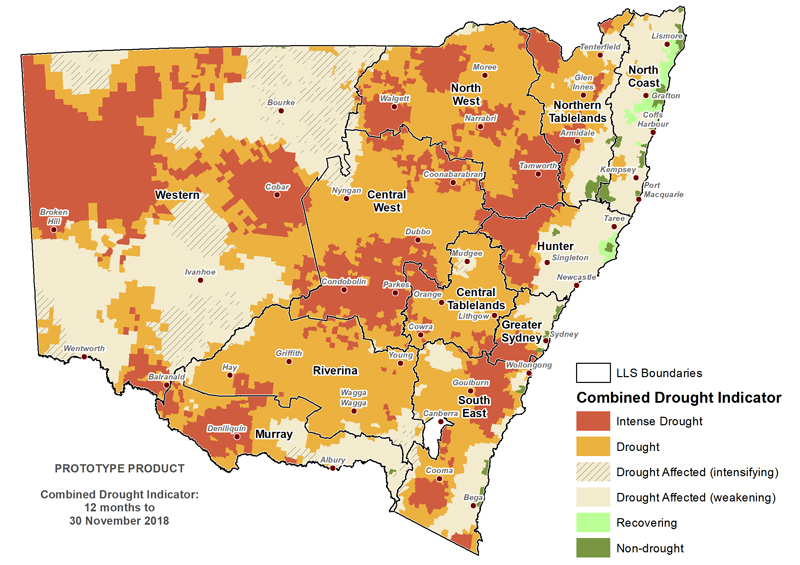
It is important to recognise the CDI provides an aggregated view of the State, and that on-ground conditions can be different to those displayed in the maps. They provide an ‘on average’ view of a particular region only. To report local conditions use DPI Farm Tracker.
Rainfall
Rainfall was generally average to above average across the majority of NSW, however areas to the north-east of the state experienced below to very much below average rainfall. Rainfall totals (Figure 2) ranged from 10-100mm across the majority of the state. Scattered storm events, including the very large low pressure system on 28-29 November, saw rainfall totals of above 100mm in the Central Tablelands, Greater Sydney and South East Local Land Services regions, and high falls of rain were also recorded in the Alpine Zone during November.
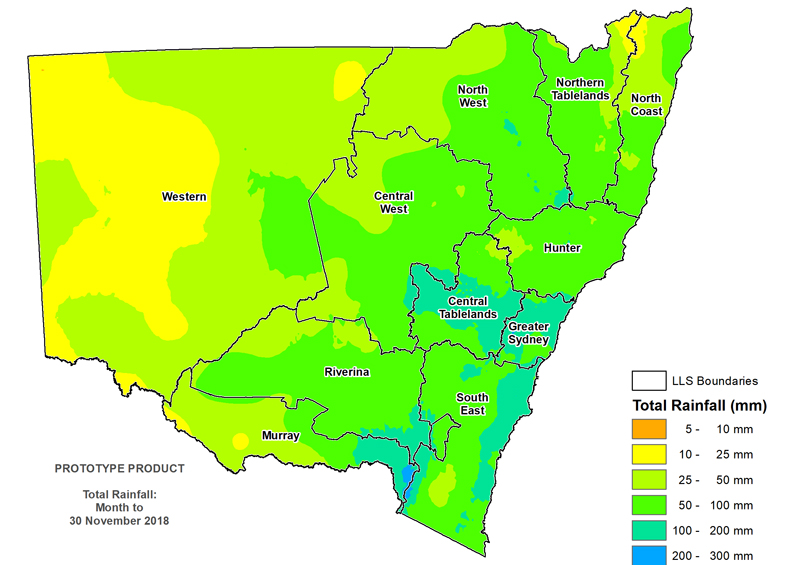
Temperature
The majority of NSW experienced average daytime temperatures during November. Daytime temperatures (Figure 3) ranged between 18 – 36°C, except for the alpine regions which ranged between 12 – 18°C. Overnight temperatures were average to above average across most of NSW and ranged between 6 – 21°C, except in the alpine regions which ranged between 3 – 6°C (Figure 4).
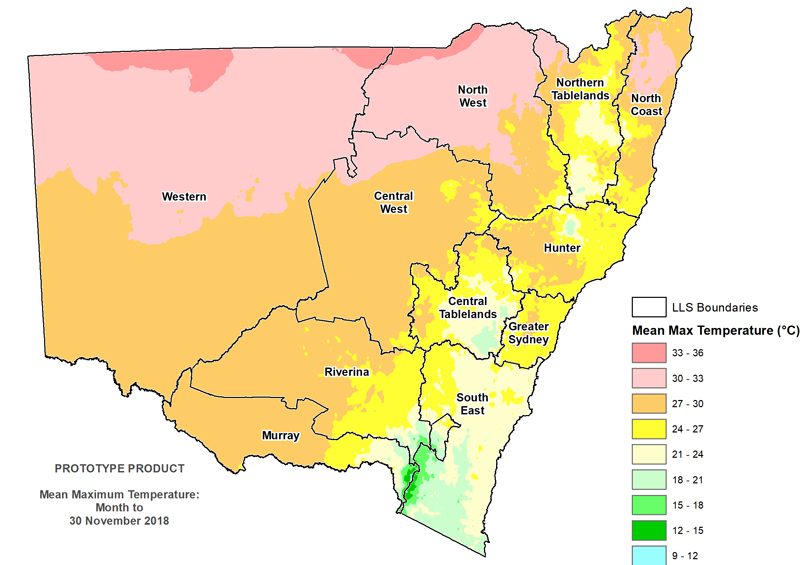
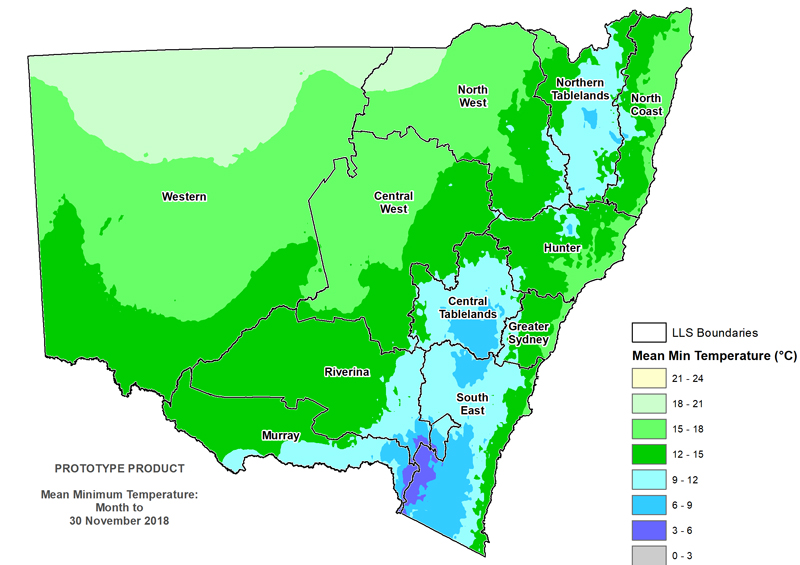
Normalised Difference Vegetation Index (NDVI) Anomaly
The monthly NDVI anomaly (Figure 5) indicates lower than normal greenness extending across most of NSW during November. Although there has been noticeable improvement in the NDVI anomaly across large parts of the state during November, plant growth remains poor considering that conditions have been below normal across NSW for the past 9 – 15 months.
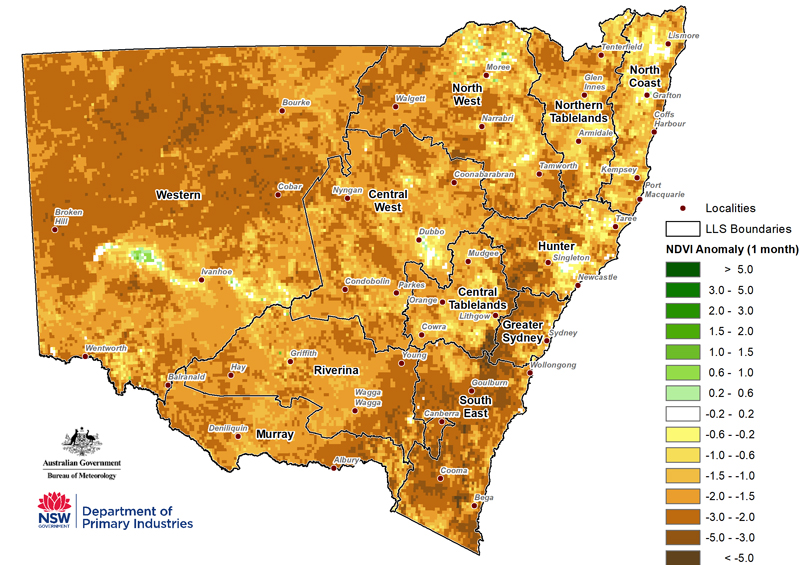
Farm Dam Water Status
Stock water levels remain critically low across large parts of NSW, with farm dam surface areas decreasing in most regions, as indicated by the farm dam surface area assessment in Figure 6. Critically low areas can be identified in most LLS regions, but the most extensive areas of concern cover much of the Western, North West and Central West. There are also large areas of concern in the western Murray and Riverina, reflecting the continuing drought conditions during November. Despite heavy falls of rain during November, coastal regions saw a moderate reduction in farm dam extents. The rainfalls in late November were not captured in this data. Alpine regions saw slight improvements in water extent due to higher rainfall at altitude.
The assessment is a collaboration between DPI and Geoscience Australia’s Digital Earth Australia Program, and is the first ever widespread audit of farm dam conditions in NSW. A new methodology was applied which uses high resolution remote sensing to: detect and map all water bodies (including farm dams) in the size range 3125 m2 – 10 km2; exclude storages that are potentially part of irrigation schemes or river reaches; and compare the current water surface area in each dam to the maximum extents for the period 2000 – present. Area calculations were undertaken for 47,000 individual water bodies across NSW and aggregated to the parish level for reporting (Figure 6).
The methodology and resulting map in Figure 6 are a prototype, and there needs to be more comprehensive field verification as well as further refinements to the techniques of farm dam detection and exclusion of irrigation storages. The work has been presented in this month’s State Seasonal Update because of the continuing drought and concerns about stock water status leading into summer. The data also provides a means of verifying the drought indices, with a comprehensive data source that is independent of the meteorological network.
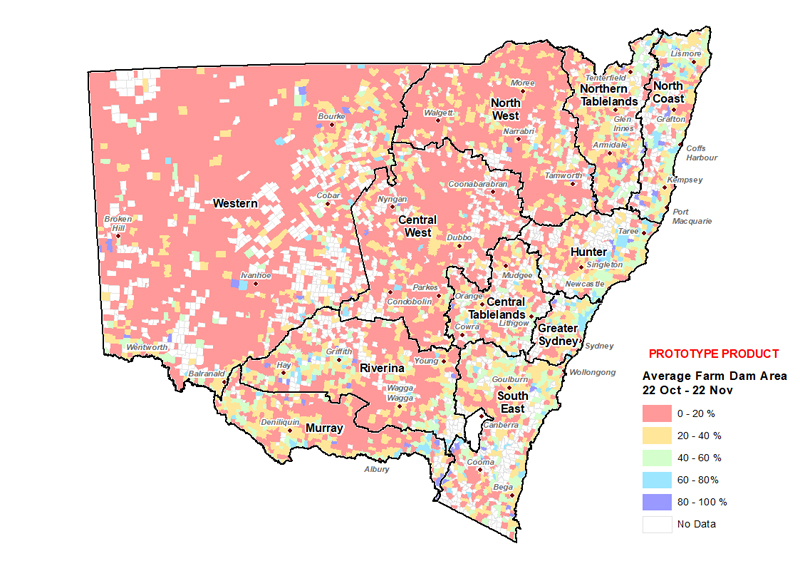
Extreme events
A very large low pressure system impacted NSW on 28 – 29 November with falls over 100mm being recorded in parts of the Sydney basin down to Wollongong. The full agronomic impact of this event will not be evident in the objective drought indicators for some weeks.
Rainfall Index
The Rainfall Index (RI, Figure 7) shows that the majority of NSW continues to be experiencing below average to extremely low rainfall. There are some areas of the state that are experiencing average rainfall, including an area to the west and north-west of Ivanhoe and north of Bourke in the Western Local Land Services (LLS) region, alpine regions in the Murray LLS region, along with parts of the Hunter, Northern Tablelands and North Coast LLS regions.
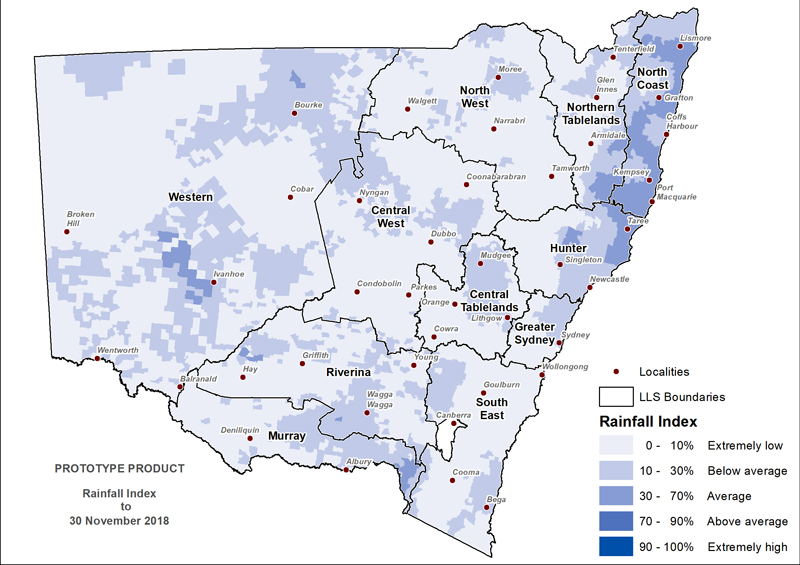
Soil Water Index
The Soil Water Index (SWI, Figure 8) shows that the majority of NSW has stored soil moisture at below average to extremely low levels, when considering conditions over a twelve month window. There are parts of the Hunter, Northern Tablelands and North Coast LLS regions that are at average levels.
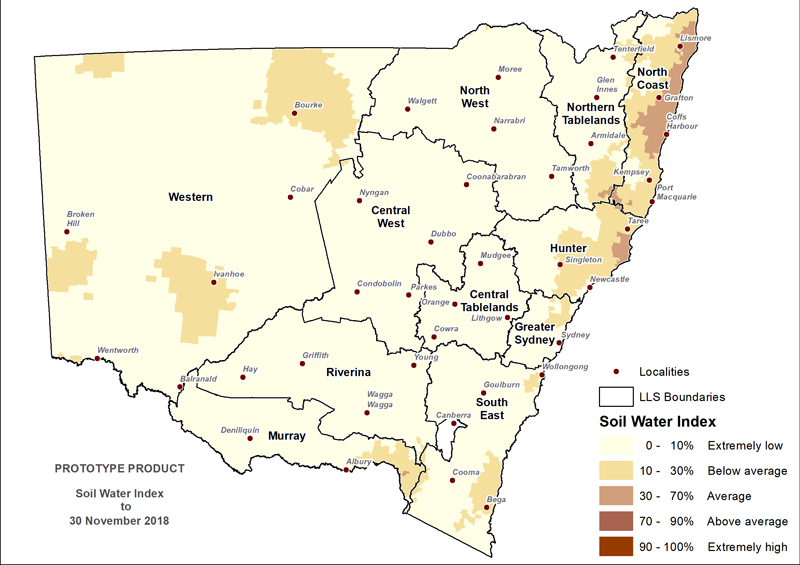
Plant Growth Index
The Plant Growth Index (PGI, Figure 9) is below average to extremely low across most of NSW and largely reflects the SWI. There are some isolated pockets along the NSW coastline where conditions are currently considered average.
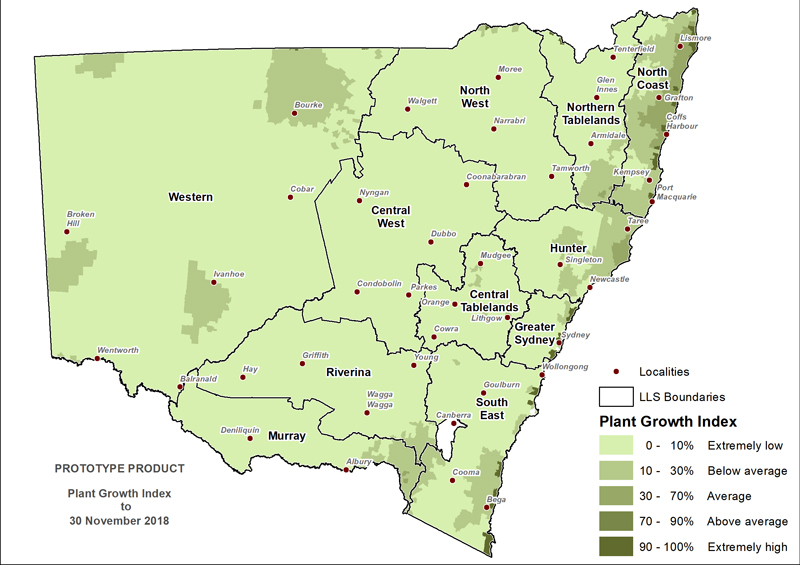
Drought Direction Index
The Drought Direction Index (DDI, Figure 10) indicates that the areas experiencing a positive trend (drought becoming less intense or improving conditions) has expanded since the October State Seasonal Update. Ongoing falls of rain are needed to ensure conditions improve in these areas.
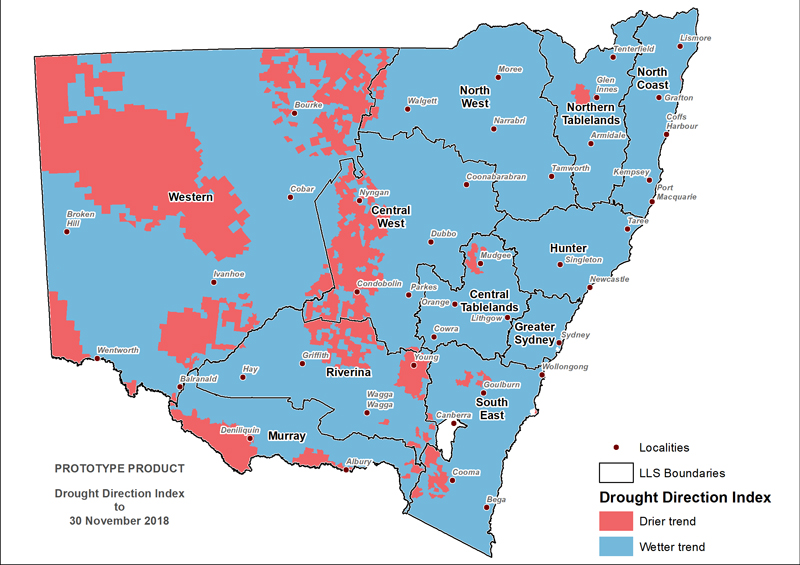
Changes in the individual drought indicators may have occurred since this update was released. For the most current information, please visit Drought Hub.
CDI status for the regions
Figure 11 displays the CDI status for each individual Local Land Services region to 30 November 2018.
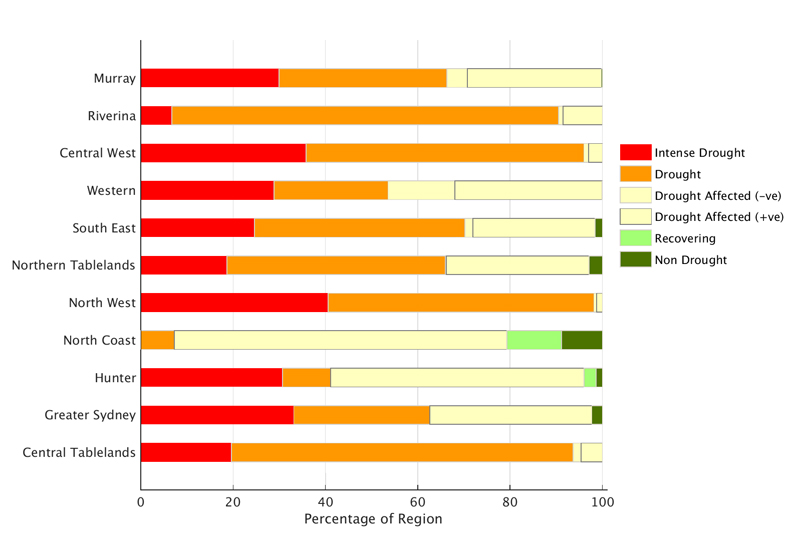
Murray and Riverina regions
Drought has expanded and intensified in the Murray and Riverina Local Land Services (LLS) regions during November (Figure 12). Areas in Intense Drought have developed since the October State Seasonal Update (SSU) with regions around West Wyalong, Deniliquin, Gundagai, east of Hay and Barham now in the Intense Drought category. These regions have missed recent rainfall recorded across the Riverina and Murray LLS regions, with the Drought Direction Index remaining negative in many of these areas. At the time of writing, these areas are deteriorating and the areas transitioning into Intense Drought expanding.
To the east of the Murray and south-east Riverina LLS regions conditions are relatively better, with the area being in the Drought Affected category, although significant rainfall has been recorded in the alpine zone.
The monthly NDVI anomaly data (Figure 13) indicates improvement in conditions since the October SSU, however the entire region is still below average levels of greenness for November. This is likely to reflect the condition of some dryland crops and irrigated zones in these districts.
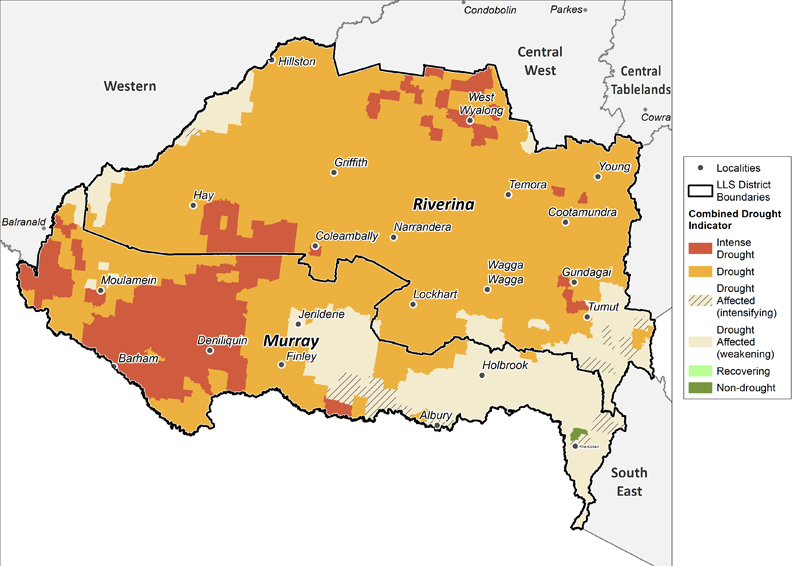
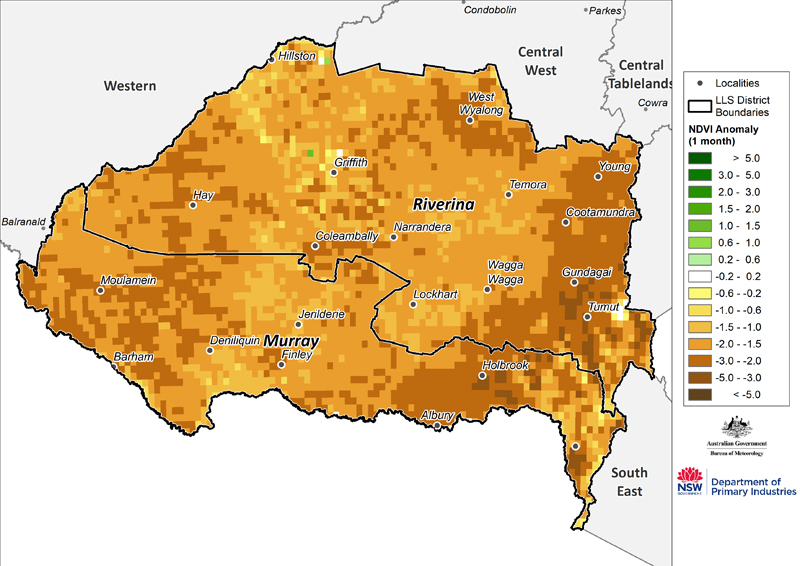
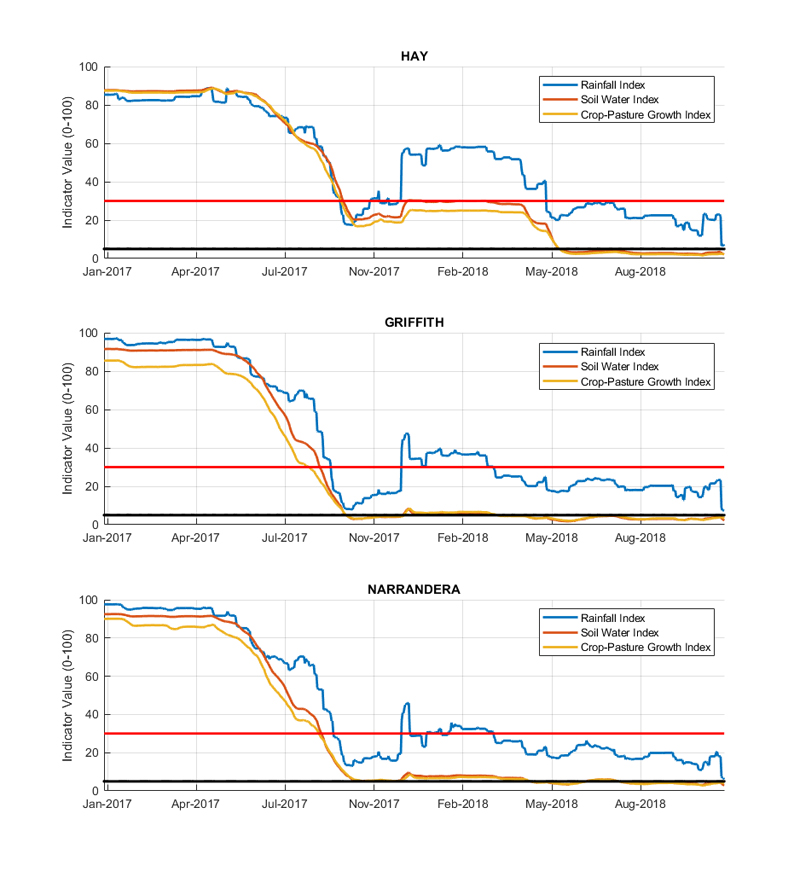
Western region
The Western Local Land Services (LLS) region continues to experience drought conditions with the entire region being in one of the three drought categories of Drought Affected, Drought or Intense Drought (Figure 15). At the time of writing, the drought indicators have the drought event expanding and intensifying, particularly in the north-west and south of the LLS region. Scattered storms have bought some minor relief to farms in the east of the region, although the meteorological network is not dense enough to accurately capture storm rainfall on a farm by farm basis. Available field reports indicate that many livestock producers in this region are still feeding livestock.
The monthly NDVI anomaly data (Figure 16) indicates there has been little change in plant conditions across the region since the October State Seasonal Update. This means that there is minimal grass cover across large parts of the LLS region, with risks like dust storms and erosion loss remaining extremely high. There is a region to the east of Menindee towards Ivanhoe that is exhibiting a strong greening response, the agronomic effects of a very high rainfall event that was recorded towards the end of September. This response is not large enough in geographic area to change the characterisation of drought by the Combined Drought Indicator.
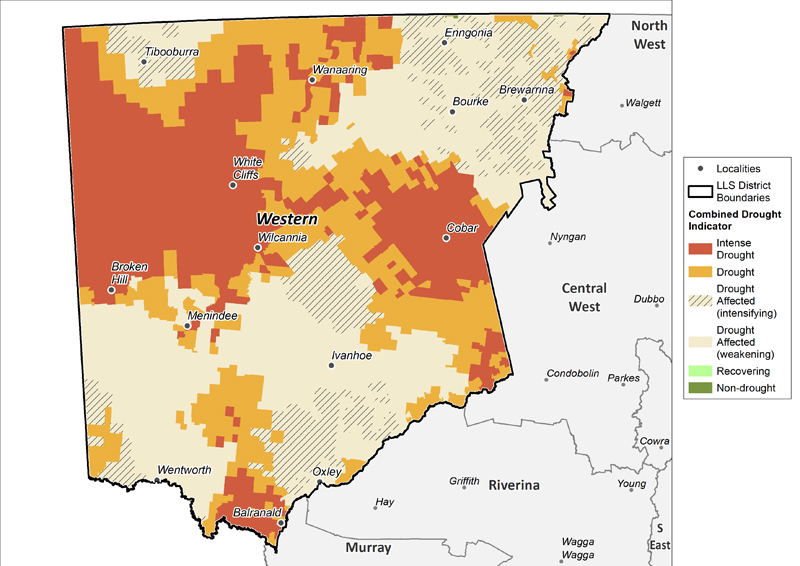
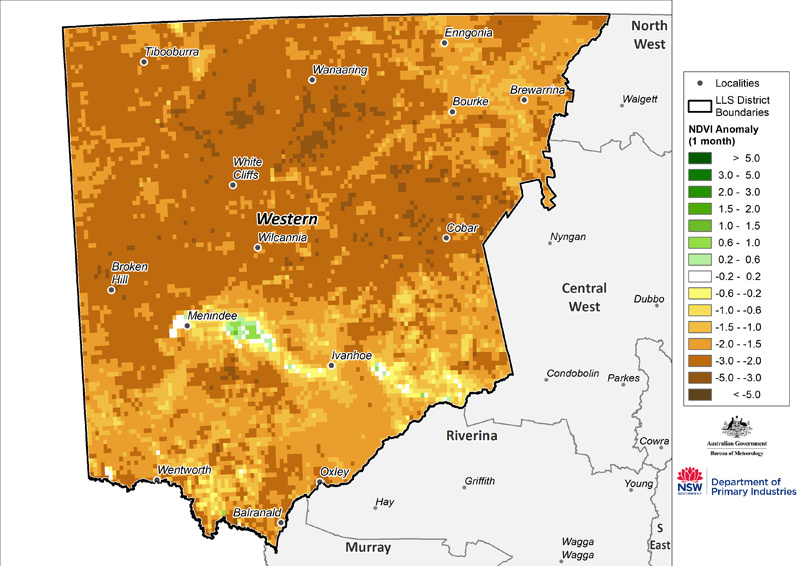
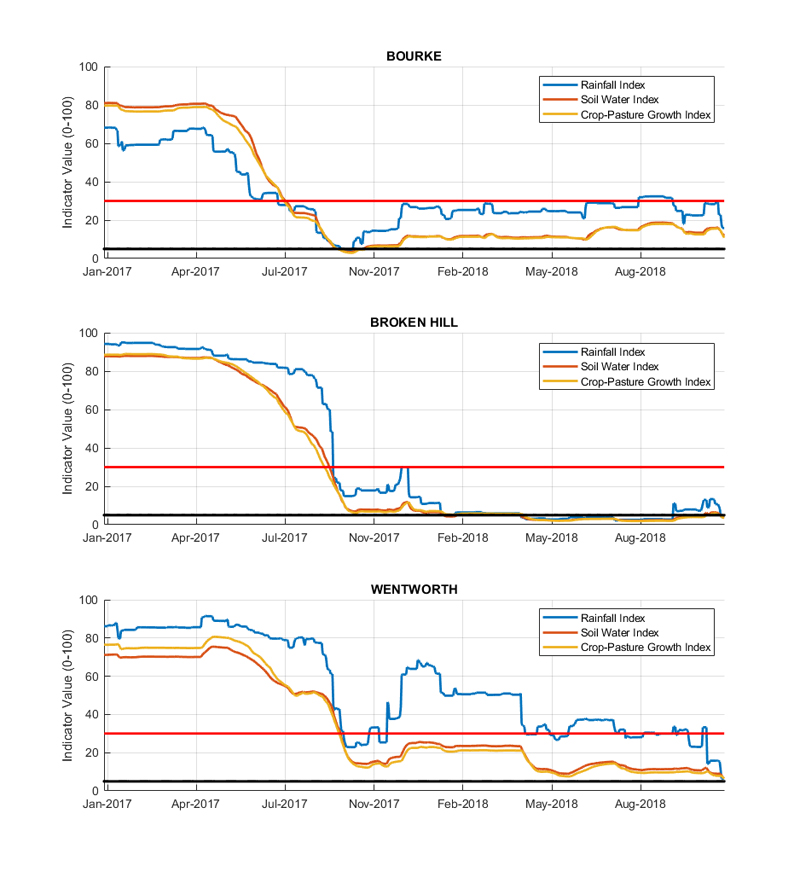
North West, Northern Tablelands and North Coast regions
Conditions across the North West, Northern Tablelands and North Coast Local Land Services (LLS) regions have deteriorated since the October State Seasonal Update (Figure 18). Information from the Combined Drought Indicator (CDI) shows that the North West has seen the greatest decline in conditions with approximately 50% of the LLS region falling into the Intense Drought category. Areas around Walgett, west of Moree, Narrabri, Wee Waa, Barraba, Tamworth and Quirindi are currently in the Intense Drought category. Conditions in the Northern Tablelands LLS region remain relatively stable, though conditions have deteriorated to the regions east of Deepwater and around Cullendore. These areas and those surrounding Yetman and Armidale are currently in the Intense Drought category.
There are still signs of recovery in the North Coast LLS region with areas around Ballina, Yamba, south and east of Grafton and Uranga in the Recovering category and to the west of Wauchope in the Non-Drought category. The North Cost LLS regions has also experienced deterioration in conditions, particularly to the north-west of Kempsey and north-west of Grafton.
The monthly NDVI anomaly data (Figure 19) indicates that there a varied response in plant condition across the LLS regions during November. This reflects both irrigated cropping and highly variable storm rainfall across this region over the last two months. As a whole, there are large areas of dryland agriculture where plant response remains well below expectations for this time of year. There are areas of average plant greenness around Grafton, west of Lismore and south-west of Manilla. These areas are responding to falls of rains that have been experienced in these parts over the past two months.
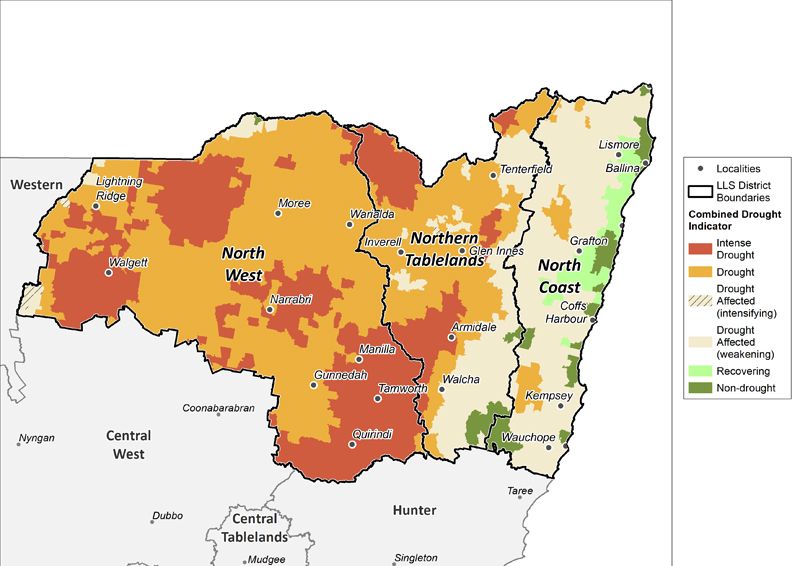
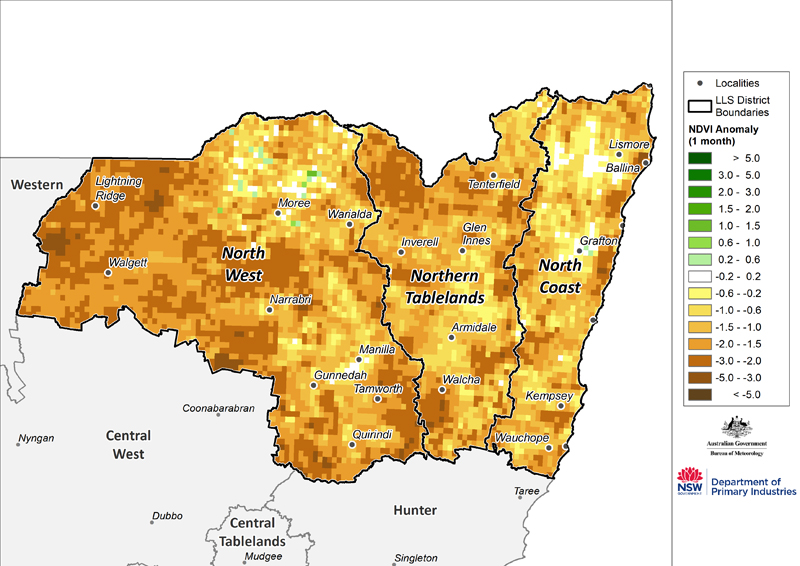
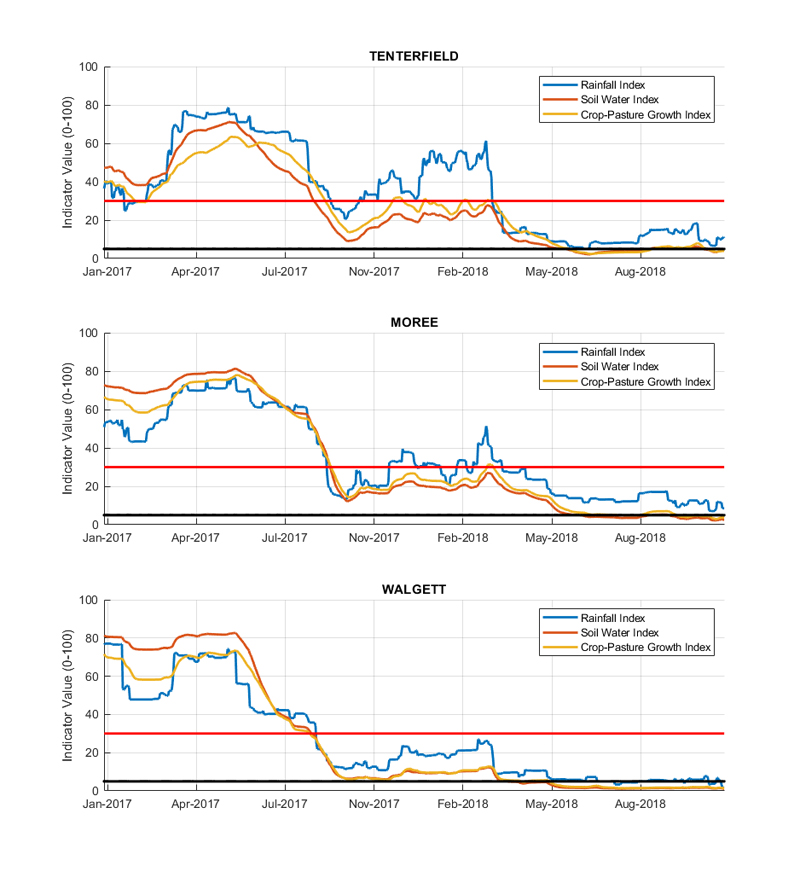
Central Tablelands, Central West, Hunter and Greater Sydney regions
There is a large transition in conditions across the Central Tablelands, Central West, Hunter and Greater Sydney Local Land Services regions (Figure 21). To the east, the Sydney Basin and eastern Hunter have had substantial rainfall over the past two months. While the Combined Drought Indicator (CDI) remains in the Drought Affected category, the rainfall has been significant enough to promote early recovery from the drought event.
Areas of the high rainfall zone have enjoyed similar conditions, and farms located at high altitudes are experiencing reasonable pasture production. However there are strong spatial gradients across this part of the state where conditions deteriorate rapidly as altitude decreases. For this reason the CDI classifies these regions as being in the Drought category, despite some favourable conditions being experienced on some properties.
In the west of these LLS regions, the drought event continues despite some minor falls of rain occurring in early November. In some regions these were enough to lift the Rainfall Indices above the 5% threshold and the CDI to temporarily change from Intense Drought to Drought. It is important to recognise that field conditions (e.g., pasture growth) remained very poor throughout the month and practices like livestock feeding continued.
In summary, the CDI shows that the majority of the regions remains in one of the three drought categories of Drought Affected, Drought or Intense Drought. The Central West Local Land Services (LLS) region has seen a decline in conditions since the October State Seasonal Update (SSU). Areas currently in Intense Drought include Forbes, Parkes, Condobolin, Lake Cargelligo, Dubbo, Coonabarabran and Coonamble. The Central Tablelands and Greater Sydney LLS regions remains relatively unchanged. The Hunter LLS regions continues to experience varied conditions with the western parts of the region in Intense Drought and the central and eastern parts in Drought Affected. There is a small area surrounding Forster that continues to fall into the Recovering or Non-Drought category, though the extent of this area has retracted since the October SSU.
The monthly NDVI anomaly data (Figure 22) shows continued improvement in plant condition since the October SSU, particularly in the east of these regions. There are currently parts of the LLS regions experiencing average levels of greenness including to the south-east of Dubbo, Gloucester, Taree, Gulargambone and the east of Singleton. This improvement is in response to falls of rains that have been experienced in these parts over the past two months.
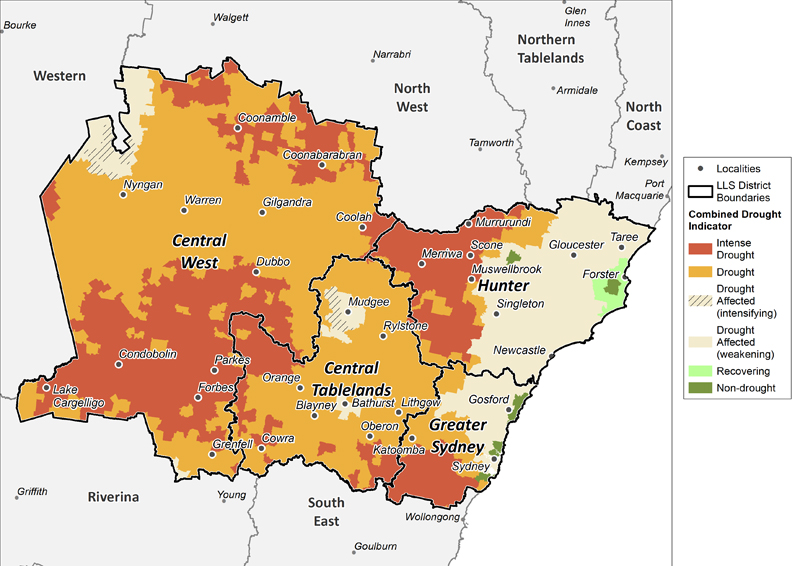
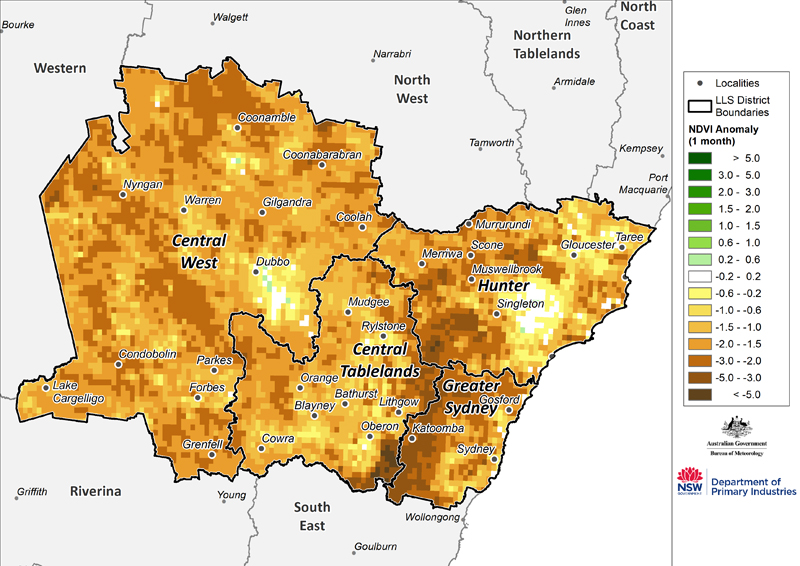
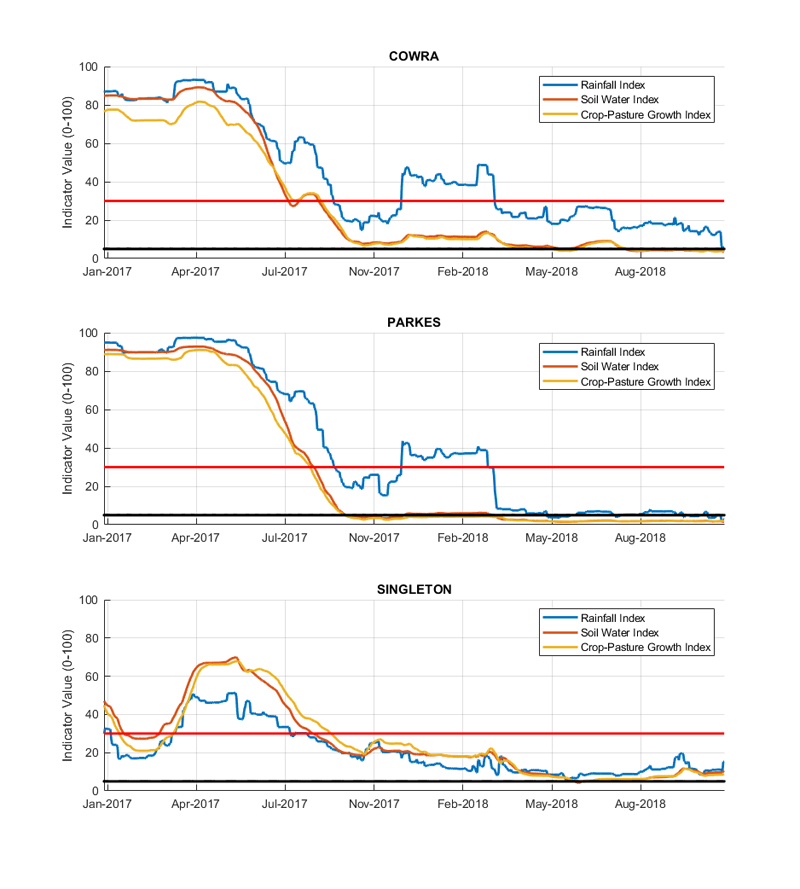
South East region
Conditions across the South East Local Land Services (LLS) regions have deteriorated since the October State Seasonal Update (Figure 24). Information from the Combined Drought Indicator (CDI) shows that approximately 25% of the LLS region falls into the Intense Drought category, including areas around Eden, south of Cooma, east of Jindabyne, east and north of Bredbo, south-east of Queanbeyan, west of Mittagong and Nowra. The areas in Drought have also expanded since the October State Seasonal Update.
Areas of the high rainfall zone (e.g. Crookwell through to Goulburn) have had good falls of rain, and farms located at high altitudes are experiencing reasonable pasture production. However there are strong spatial gradients across this part of the state where conditions deteriorate rapidly as altitude decreases. For this reason the CDI classifies the regions as being in the Drought category, despite some favourable conditions being experienced on some properties.
The monthly NDVI anomaly data (Figure 25) indicates some isolated areas of improvement in the level of greenness being experienced. The area around Crookwell continues to show signs of improvement, as does coastal regions near Wollongong, Batemans Bay and Bega, along with the alpine region and south of Bombala. However plant conditions are still below what would normally be expected for November.
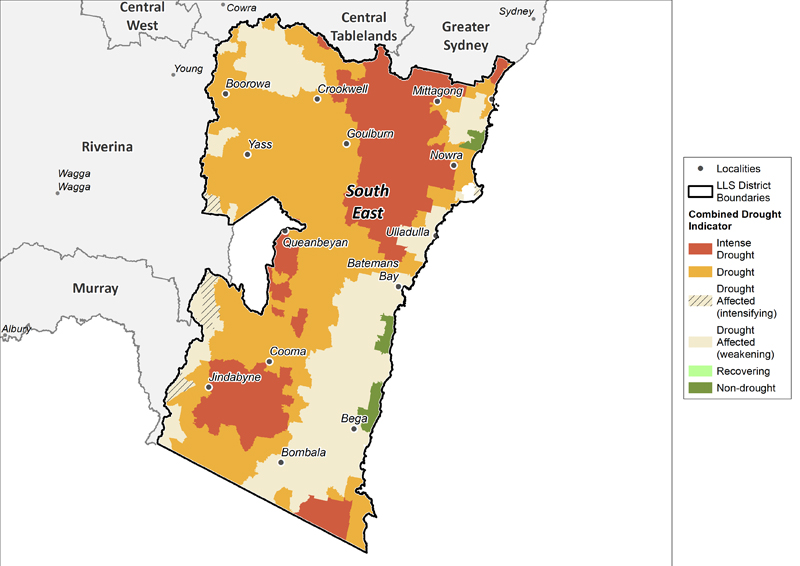
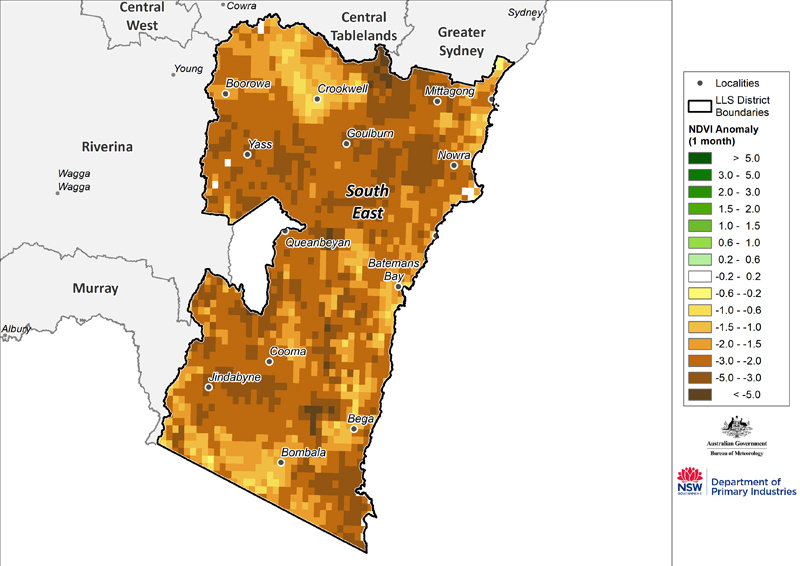
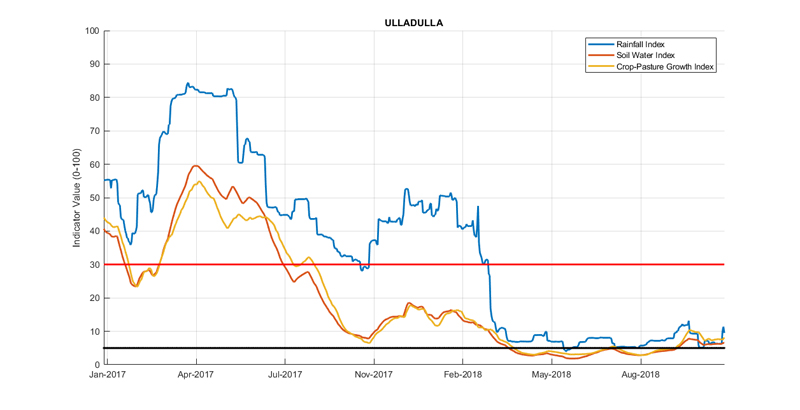
Official national outlook
The official national climate outlook for December to February was issued by the Bureau of Meteorology on 29 November 2018. The outlook shows that large parts of Western Australia, Queensland and the northern parts of the Northern Territory are likely to be drier than average over the next three months. Elsewhere there is a near equal chance of it being drier or wetter than average.
December to February daytime temperatures have an increased likelihood of being warmer than average across most of Australia. Overnight temperatures also have an increased likelihood of being warmer than average across Australia, except for the far west of Western Australia which has an equal to slightly greater chance of cooler than average temperatures.
NSW outlook
For New South Wales, the rainfall outlook (Figure 27) for December to February indicates that there is a near equal chance (40-60%) of wetter or drier than average conditions across most of NSW for the next three months. The exceptions is in the north of the state, which has an increased chance (between 60-65%) of drier than normal conditions.
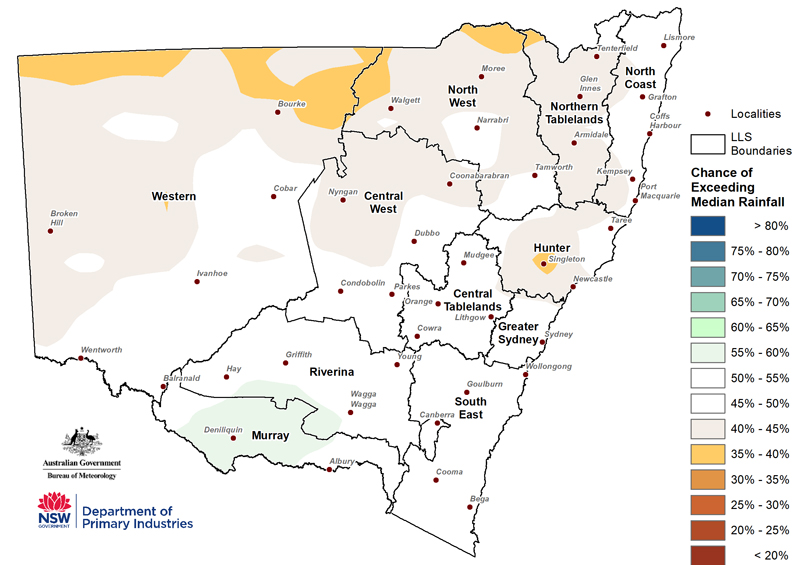
The temperature outlook (Figures 28 & 29) indicates that there is an increased chance (above 75%) of warmer than average daytime and overnight temperatures across all of NSW.
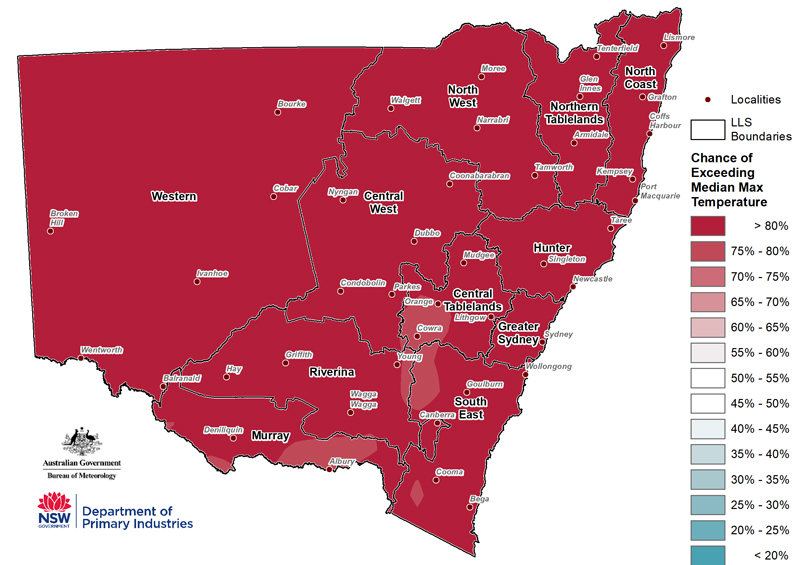
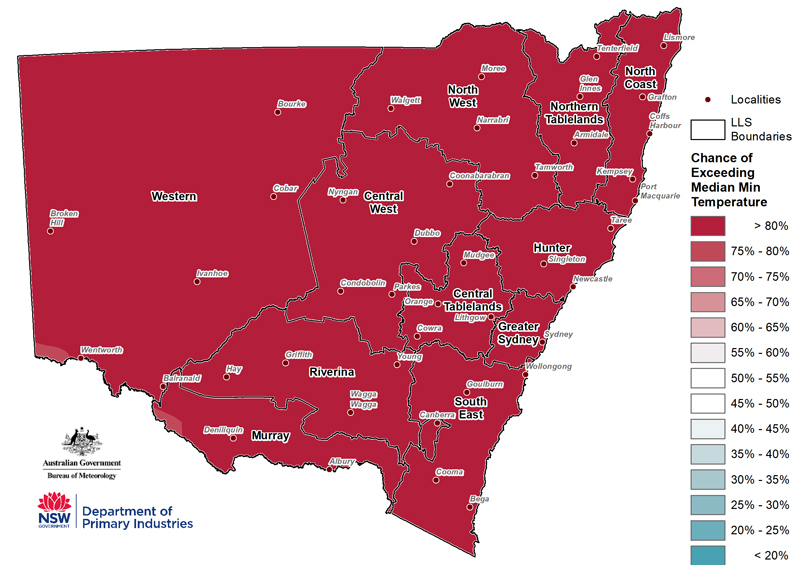
Climate drivers
ENSO
As of 4 December 2018, the Bureau of Meteorology’s ENSO Outlook remains at El Niño Alert. Some atmospheric El Niño indicators remain below El Niño thresholds (including trade winds, cloud levels and the SOI), indicating that the tropical ocean and atmosphere are not reinforcing each other and are “uncoupled”, which is required to sustain an ENSO event. However, international climate models predict Pacific Ocean sea surface temperatures will remain at or above El Niño levels through February.
Southern Oscillation Index and other indicators
The 30-day SOI value as of 2 December was positive (30 day value was +1.6, 90 day value was -2.2) but is in a range that is considered neutral, and has been neutral since early September (Figure 30).
Cloud levels at the junction of the equator and the International Date Line has fluctuated around average during the last month. Whilst below average cloud levels is usually indicative of La Niño, the overall pattern of cloud levels across the Pacific has been more consistent with a neutral ENSO.
Trade winds are currently weaker than average across the western and central tropical Pacific. Generally during an El Niño there is a sustained weakening of trade winds across much of the tropical Pacific, however this weakening would need to persist for an event to become established.
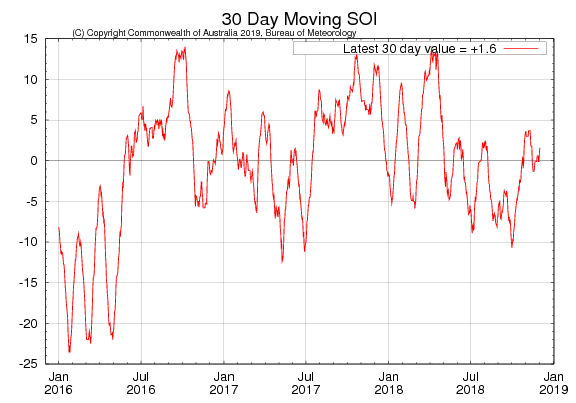
Sea surface temperatures
Monthly sea surface temperatures anomalies (SST) for November (Figure 31) were slightly warmer than average across the equatorial Pacific Ocean. The November values for NINO3 were +0.9°C, NINO3.4 +0.9°C and NINO°4 +0.9.
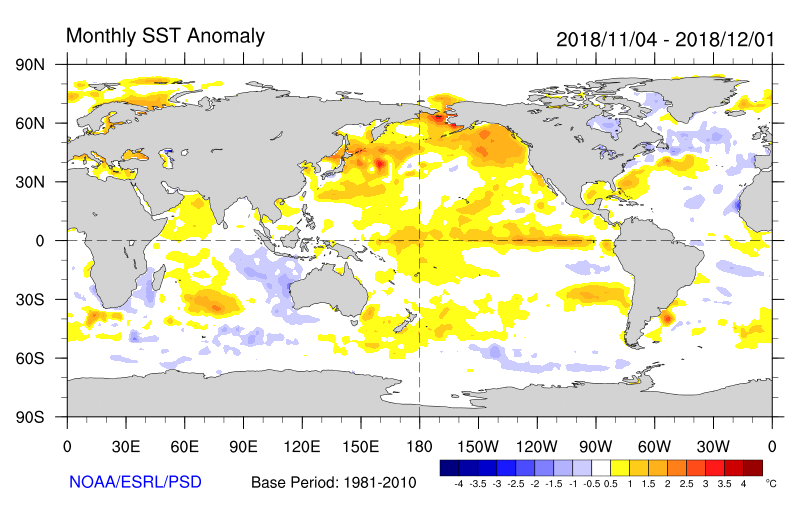
Sea Sub-surface Temperatures
Sub-surface temperatures (Figure 32) shows that warm anomalies in the sub-surface has slightly weakened over the past month. A large pool of anomalously warm water extends across the sub-surface of the equatorial Pacific, with small parts being more than 3°C warmer than average.
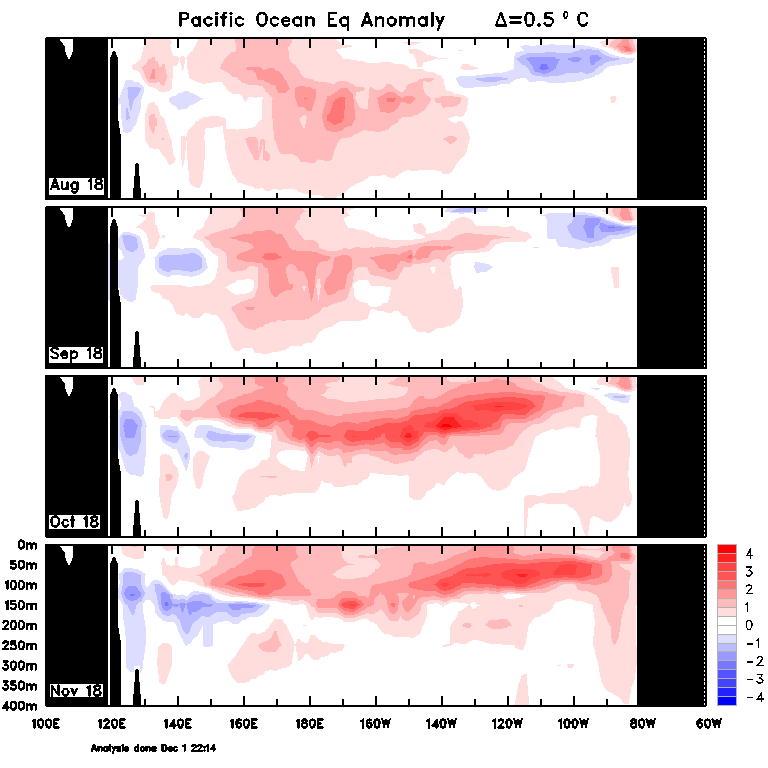
Indian Ocean
The Indian Ocean Dipole (IOD) is currently slightly positive (+0.34 as of 2 December 2018). Consistent with the IOD’s natural cycle, the positive IOD event is weakening. The IOD typically has little influence on Australian climate from December to April, due to the movement of the monsoon trough in the Indian Ocean.
Southern Ocean
The Southern Annular Mode (SAM) is currently neutral and expected to be weakly positive in the first half of November. A positive SAM during summer typically creates low pressure over southern Australia and could bring above average rainfall.
How does it work?

Much of the information in the Seasonal Conditions Report is sourced from the NSW DPI Enhanced Drought Information System (EDIS) ™. The EDIS system is currently available in prototype form and is subject to an intensive ground truthing process. For more information, visit the interactive website via Drought Hub.
EDIS is an ongoing project aimed at improving the quality and timeliness of efforts to monitor conditions across the state. Key features of the system are:
- It tracks drought by using four indicators; rainfall, soil water, plant growth, as well as tracing rainfall trends. Agronomic conditions have equal value to rainfall recorded at meteorological stations.
- The Combined Drought Indicator (CDI) brings this information together, and has been designed to characterise developing drought conditions. The key purpose for building the CDI was as a drought early warning system.
- The rainfall, soil moisture and plant growth indicators in EDIS account for conditions over a 12 month window. This provides a compromise between a highly sensitive indicator (e.g. six months) and a less sensitive indicator (e.g. 24 months).
- Climate and remote sensing data drive the information system at a high resolution, but the CDI is reported at a Parish level.
- Because of its configuration and purpose, there will be differences to the indicator used in the National Drought Monitoring Framework (the Australian Rainfall Deficiency Analyser) which relies on rainfall alone.
- The CDI has three drought categories that characterise NSW according to drought intensity as well as the main drivers of a drought event (meteorological, hydrological and agronomic). DPI considers areas Drought Affected to be experiencing a drought event.
- The Drought Affected category encompasses a wide range of conditions from the very early stages of drought entry through to a drought event becoming intense. This enables the drought monitoring system to detect a drought event early. It is also possible to stay in the Drought Affected category for some period of time.
The way in which the indicators are combined to form the CDI is described in Table 1 below.
Table 1: The way EDIS indicators are combined.
CDI Phase | Technical definition | Description - typical field conditions |
|---|---|---|
Intense Drought | All three indicators (rainfall, soil water, plant growth) are below the 5th percentile | Ground cover is very low, soil moisture stores are exhausted and rainfall has been minimal over the past 6-12 months. |
Drought | At least one indicator is below the 5th percentile | Conditions may be very dry, or agronomic production is tight (low soil moisture or plant growth). It is possible to be in Drought when there has been some modest growth, or a few falls of rain. |
Drought Affected (intensifying) | At least one indicator is below the 30th percentile and the rainfall trend is negative over the past 90 days. | Conditions are deteriorating; production is beginning to get tighter. Ground cover may be modest, but growth is moderate to low for the time of year. When indicators are close to the Drought threshold drought conditions are severe. |
Drought Affected (weakening) | At least one indicator is below the 30th percentile and the rainfall trend is positive over the past 90 days. | Production conditions are getting tighter, but there have been some falls of rain over the past month. It is rare to enter the Recovering phase from the Non-Drought category; Usually there is a quick (1-2 week) transition into Drought Affected or Drought. When indicators are close to the Drought threshold drought conditions are severe. |
Recovering | All indicators are below the 50th percentile but above the 30th percentile | Production is occurring but would be considered ‘below average’. Full production recovery may not have occurred if this area has experienced drought conditions over the past six months. |
Non-drought | At least one indicator is above the 50th percentile. | Production is not limited by climatic conditions. |
The NSW State Seasonal Update is provided each month by the NSW DPI Climate Unit, which is part of the Livestock Systems Branch in DPI Agriculture.
Information used in this report was primarily sourced from the Australian Bureau of Meteorology, the US National Oceanic and Atmospheric Administration, the International Research Institute for Climate and Society (Columbia University), Geoscience Australia’s Digital Earth Australia Program, and NSW Department of Primary Industries.
Maps in this document contain data which is © Spatial Services – NSW Department of Finance, Services and Innovation (2018), Panorama Avenue, Bathurst 2795 and data which is © Commonwealth of Australia 2018, Australian Bureau of Meteorology, Melbourne. All rights reserved.
The seasonal outlooks presented in this report are obtained from the Australian Bureau of Meteorology and other sources (including World Meteorological Organisation Global Producing Centres). These outlooks are general statements about the likelihood (chance) of (for example) exceeding the median rainfall or minimum or maximum temperatures. Such probability outlooks should not be used as categorical or definitive forecasts, but should be regarded as tools to assist in risk management and decision making. Changes in seasonal outlooks may have occurred since this report was released. Outlook information was up to date as at 3 September 2018.
All climate and remote sensing input data is supplied to the Enhanced Drought Information System ™ under the Australian Creative Commons Licence (CCY 4.0) and is made available by the Terrestrial Ecosystem Research Network.
© State of New South Wales through the Department of Industry, Skills and Regional Development, 2018. You may copy, distribute and otherwise freely deal with this publication for any purpose, provided that you attribute the NSW Department of Primary Industries as the owner.
Disclaimer: The information contained in this publication is based on knowledge and understanding at the time of writing (December 2018). However, because of advances in knowledge, users are reminded of the need to ensure that information upon which they rely is up to date and to check currency of the information with the appropriate officer of the Department of Primary Industries or the user’s independent adviser.
Published by the NSW Department of Primary Industries. ISSN 2202-1795 (Online). Volume 6 Issue 9

